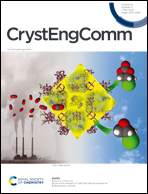The different magnetic relaxation behaviors in [Fe(CN)6]3− or [Co(CN)6]3− bridged 3d–4f heterometallic compounds†
Abstract
For investigating how different 3d ions influence the magnetic relaxation behaviors of 3d–4f systems, six isomorphic tetranuclear 3d–4f compounds of [LnFe(CN)6(H2L)(H2O)(DMF)]2·5H2O (Ln = Dy(1), Tb(2), Ho(3), (H2L = 2,6-diylbis(ethan-1-yl-1-ylidene)-di(isonicotinohydrazide))) and [LnCo(CN)6(H2L)(H2O)(DMF)]2·5H2O (Ln = Dy(4), Tb(5), Ho(6)) were obtained from [M(CN)6]3− bridging LnIII-Schiff-base units. The six isostructural compounds are all centrosymmetric with two nine-coordinated LnIII ions in a muffin configuration and Cs symmetry. Magnetic analyses revealed that complex 1DyFe with a weak antiferromagnetic Dy–Fe interaction does not show a slow magnetic relaxation behavior above 2 K, while diamagnetic CoIII ions in complex 4DyCo enlarge the intermolecular Dy⋯Dy distance and induce ferromagnetic Dy–Dy interactions to suppress the quantum tunneling of the magnetization (QTM) and lead to the single-molecule magnet (SMM) behavior with an energy barrier of Ueff = 11.17 K in 1 KOe dc field. This paper gives another example of inducing paramagnetic 3d ions with weak 3d–4f coupling could not quench QTM effectively, while diamagnetic 3d ions could perform better.
![Graphical abstract: The different magnetic relaxation behaviors in [Fe(CN)6]3− or [Co(CN)6]3− bridged 3d–4f heterometallic compounds](/en/Image/Get?imageInfo.ImageType=GA&imageInfo.ImageIdentifier.ManuscriptID=D0CE00039F&imageInfo.ImageIdentifier.Year=2020)


 Please wait while we load your content...
Please wait while we load your content...